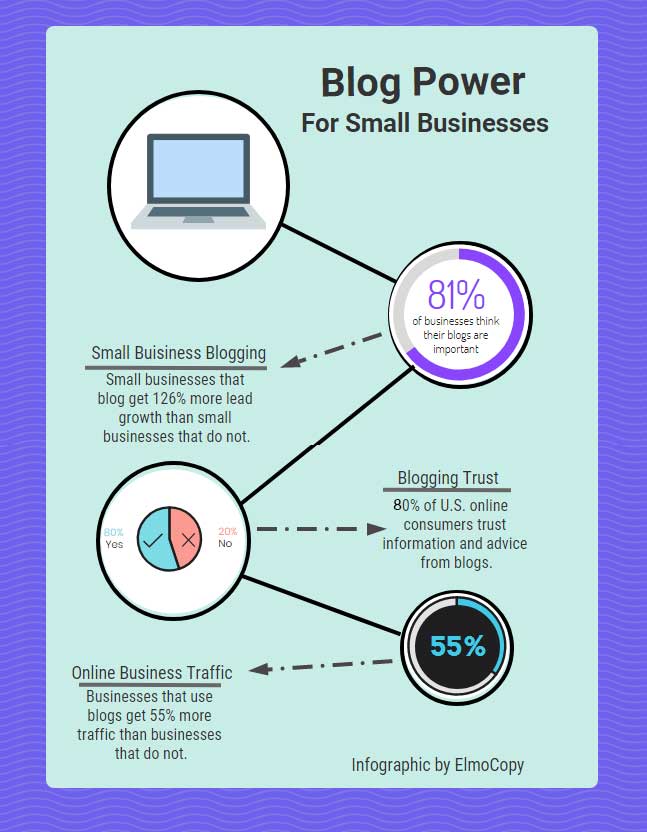I’ll bet you’re wondering, “Do I need a small business blog?”
Before I answer that, let me ask you a few questions.
- Do you have a small business that does any marketing on the Web?
- Would you like to be seen as a leader in your market or niche?
- Do you find that you’re answering the same questions over and over again with your customers?
- If you do have a Website, would you like to receive 55% more traffic than your competitors?
If you answered “yes” to any of these questions, you should consider blogging.
In this post, I’m going to show you how you can start blogging for your small business. I’m also going to show you how you can do it for next to nothing.
More Reasons Why You Need a Small Business Blog

If you’re still not convinced your small business needs a blog, take a look at these stats:
- 81% of companies consider their blogs “useful,” “important,” or “critical.” (Source: Hubspot)
- Small businesses that blog get 126% more lead growth than small businesses that do not.(Source: ThinkCreative)
- 80% of U.S. online consumers trust information and advice from blogs. (Source: BlogHer)
[ctt template=”6″ link=”J5Y8f” via=”yes” ]If you write 21 to 54 small business blog posts your traffic will increase by 30%!(Source: TrafficGenerationCafe) [/ctt]
If these facts aren’t enough for you, think about this:
Most people don’t surf the Internet to buy stuff; they usually go online to get information. Usually, they’re looking for a solution to a problem.
Here’s a real world example of what I mean.
Recently, my wife and I decided our computer/music room needs more lights in it. The one ceiling light we have in the room isn’t enough. We found that we were squinting at our sheet music while playing our instruments.
The first thing we did was jump onto the Internet to look at different types of lights. I got the idea to look up “studio lighting” which led me to a few posts and some forums that gave us a few ideas.
The posts we read had pictures and links to where we could by some flexible, curved track lighting. We clicked on the links that took us to the vendors and we made our purchase.
See how that works?
We started out looking for a solution to a lighting problem in our home. We found the solution in a small business blog which led us to buy our lights.
As you can see, the information led to a sale…And that’s what a blog can do for you!
Quick Start Template for a Small Business Blog

OK, so you now see it’s a good idea to have a blog for your business.
Now what do you do?
Start blogging.
Yep, it’s that simple. You are going to make mistakes and you are not going to get bazillions of readers in your first couple of months.
Don’t start crying a river yet, because I’m here to hold your hand and give you a good start.
Ready?
If you know nothing at all about blogging, go to this quick start guide: The Ultimate Beginner’s Guide to Blogging
This guide will show you everything you need to get started with a blog. It’s for someone with zero knowledge of blogging that wants to get started.
Warning: It is a long post, but you can skip to the parts you need the most.
Now, I’m going to give you a quick start template so you can get started blogging immediately. Follow these step by step instructions and you’ll be writing like a pro in no time.
Do Your Keyword Research First
Step 1: Do some keyword research. I use a free online keyword tool from SEObook. These guys have been around for a very long time and it’s an excellent tool.
Usually, you have to pay to use decent keyword research tools, but SEObook’s keyword tool is FREE! A lot of people use Google’s Keyword Planner tool, but if you don’t have a Google Ads account you can’t use it.
To use SEObook’s free keyword tool, get a free account. (Just a matter of giving them your email address.)
Do some searches using the keyword tool that are related to your niche. This will give you a good idea of what people are looking for. Once you’ve decided on a subject, make a list of keywords you can use in your post and save it for later.
Use a Simple Blog Post Outline
Step 2: Create an outline. I use different forms for templates. That way, I don’t waste a lot of time thinking up a structure to my posts.
You don’t have to do it just like I do. Overtime you may find a far better way of writing your own blog posts with a better template.
Here’s what my main template looks like:
- Headline
- Header Image
- Intro/Hook
- Moving Gif Image
- Promise
- Body
- Subheads Announcing Each Section or Points
- Supporting images on Each Section
- Call to Action
- Conclusion/Close
The next steps will take you through each section of the template
Write a Headline That’ll Attract Readers

Step 3: Craft a compelling headline ― Ever since the first advertisement was written; the headline is considered the most important element of your post. If you have a boring headline, you will probably kill any interest readers may have in your post.
Tip: If you go to Jon Morrow’s site, you can get a free eBook on Headlines. It’s called 52 Headline Hacksand it is an excellent resource.
I can’t emphasize enough the importance of writing a good headline. One of the reasons headlines are so difficult to write for blog post headlines are because of SEO issues. If you write too long of a headline, It’ll be harder to read in the search engine results pages (SERPS).
On my blogs, I use a plugin called Yoast. Yoast will tell me if I have too many characters/letters in my post headline. There’s a free version of Yoast and a paid version. The free version is excellent and I use it all the time.

Craft a Promising Introduction
Step 4: Write the Introduction. Once your reader looks at your headline and then decides to read more of your blog post, you must hook them again. That’s why you need a great introduction to your post.
There are several ways you can do this.
Many times just by restating the main purpose of your post with the main keywords in it is good enough. That way your reader knows for sure that she’s a solution to her problem.
Probably the best way to write an intro is to ask a question.
Here’s a good example:
“Do you ever wonder how why some bloggers get tons of traffic while others (like you) barely get any?”
In the question above you can see that the subject may be hitting a nerve with bloggers. So naturally, a reader that’s into blogging would be very interested in seeing if there is a solution to this problem in the post.
The main thing to remember is that you want to hook the reader as quickly in the post as possible. Right after you ask a question like that, you should follow up with more teaser information followed by a promise.
Usually, I tell my readers exactly what they will know by the time they finish the post. Sometimes I mention that they will get some solid bonus information if they read the post all the way to the end.

Use Subheads as “Booster Stations”
Step 5: Write Interesting Subheads. According to Yoast SEO software, you should have a new subhead about every 300 words on your post. Subheads are very similar to headlines and they are very important.
People that read on the Internet, very quickly skim for the information they are looking for. When they do so, they are usually looking at the subheads that precede new points and ideas.
So, a subhead is sort of like a “booster station” propelling a reader forward to the next section of text.
When you write your subheads, it’s a good idea to try to make them as interesting as possible, while telling your readers what the next section is about.
Another good technique is to have interesting images accompany the subheads. It not only makes the sections more interesting, but it helps to break up the text on the page.
You can also use the subheads to make the outline for your post. Since you have to use the subheads for each new section, you can create an outline using them before you start writing.
Step 6: Write the Main Body. Once you have an outline of what you want to write about, you can then start writing the main body of your post.
When writing out your main body, any promises you made in your introduction need to be over-delivered.
Why?
Because blogging is a tough business and the only way you’re going to come out on top of your niche is to dominate it with loads of high quality information.
In the main body of your post, you should make sure that your information is organized in an easy to read step by step fashion. You also want to use as many fact supporting images as you can.
End with a Powerful Conclusion
Step 7: Write Your Conclusion
Many times, bloggers overlook the conclusion of their blog posts. Actually there are several ways you can end a post that will help both you and your readers.
The Summary. This conclusion is exactly as it sounds. All you need to do to finish your post is to quickly summarize the post. You can easily do this by leaving your reader with a key fact that you may not have already told them.
I sometimes promise the reader some bonus information at the end of the post just to make sure they will want to read it to the end.
You can also use a famous quote at the end of your post to really hammer your main points.
Call to Action. This way to conclude a blog post is taken straight out of the playbooks of copywriters and advertising execs. You can end your piece by asking readers to take some sort of action. Here are a few ways to do that:
- Ask them their opinions and to leave them in your comment section
- Tell them it would really make your day if they would share the blog post on social media
- You could also ask your readers to take other kinds of action like signing up to your newsletter or RSS feed
Linking to A Similar Page. Another great way to end your blog post is to have a link to another relevant page of your site. So, if you are writing a post about drones, you could link to a page on your site where you sell them.
Tip: Internal linking (linking to another web page on your site) is great for SEO. If a person has been reading your blog post and then clicks onto another page, it means that he is not just bouncing off your site to go elsewhere.
Google keeps track of how fast people jump off of your site and calls that a “bounce rate”. The longer people stay on your site the more Google will favor it over other sites people just jump off of.
Conclusion
In this post I hope I’ve convinced you that your business, no matter how small, needs a blog. Once you start blogging, make sure that you do it regularly. You won’t see amazing results, until you have at least 30 to 50 well written blog posts.
Unless you are in a very crowded niche online, chances are you’re be so far of your local competition, you won’t believe it.
If you want to learn more about starting a small business blog, check out these other posts to get started:
The Ultimate Beginners Guide to Blogging for Money
By the way, if you could please leave comment, I’d love to hear your thoughts on this subject.
